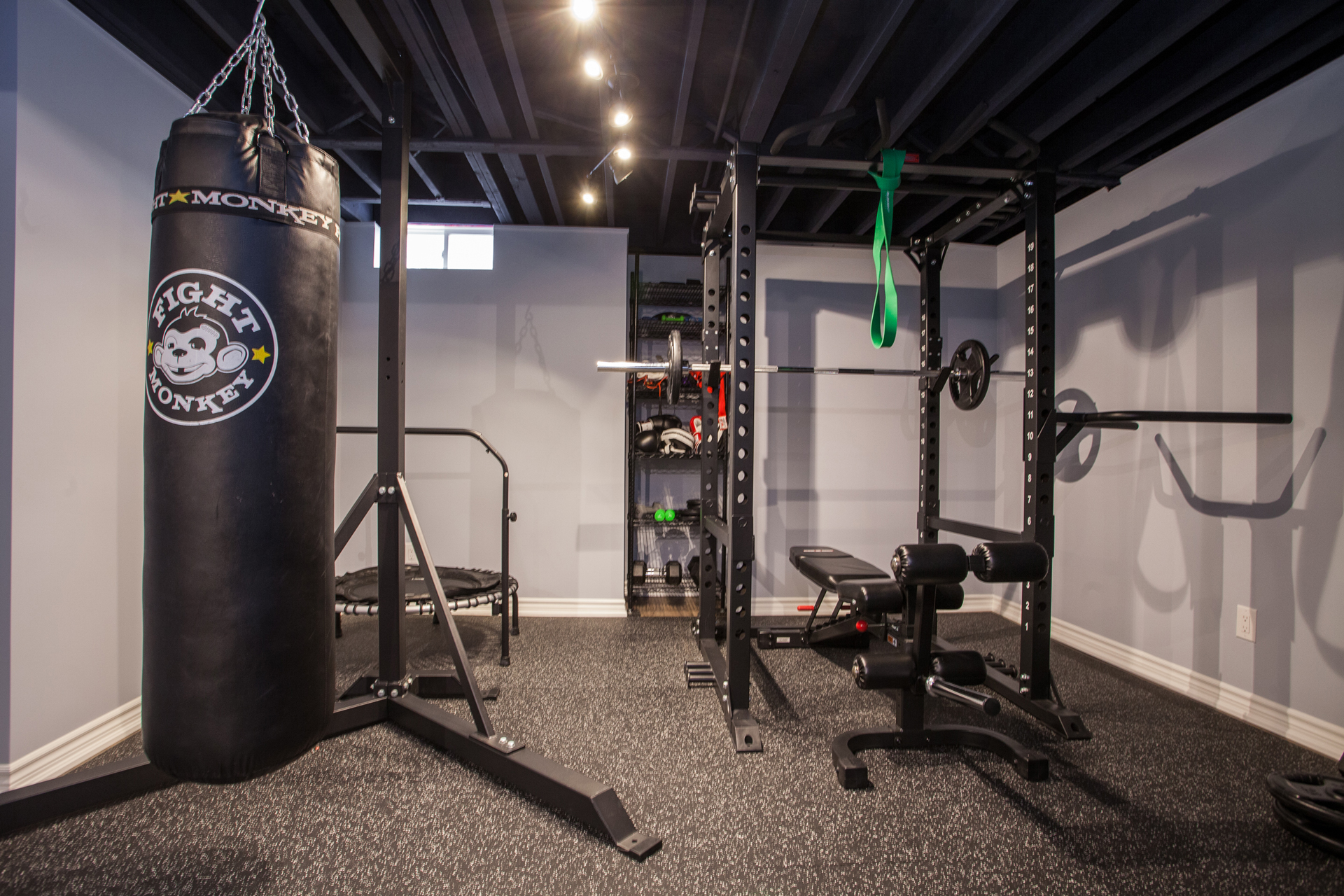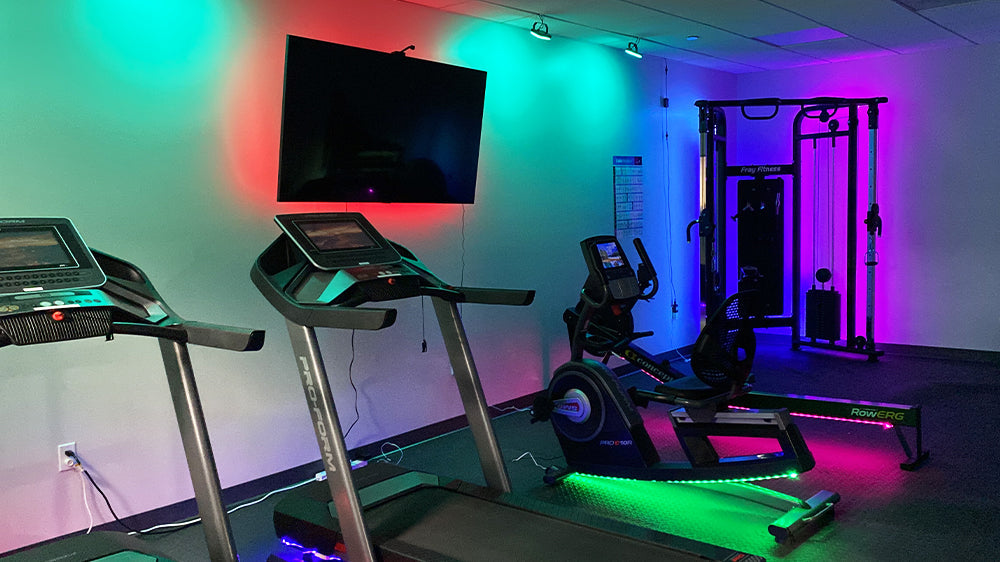You don’t need a fully renovated basement to build a functional and motivating home gym. In fact, an unfinished basement offers the perfect blank canvas for a budget-friendly fitness space. Whether you’re looking to escape expensive gym memberships or want 24/7 access to your workouts, transforming an unfinished basement into a gym can be both practical and rewarding.
This comprehensive guide will walk you through how to make an unfinished basement gym—from preparation and design to equipment, lighting, flooring, and safety.
Why Use an Unfinished Basement for a Home Gym?
While a finished basement may seem ideal, there are actually several advantages to using an unfinished basement:

Cost-Effective
You can bypass major remodeling expenses and focus only on essential upgrades like flooring, lighting, and ventilation.
Read More: 37 Small Unfinished Basement Makeover Ideas on a Budget
Larger, Open Space
Unfinished basements often have wide-open layouts without interior walls, making it easier to fit equipment and customize the space.
Read More: 55 Partially Finished Basement Ideas: Budget-Friendly and Stylish Solutions
Noise-Friendly
The concrete foundation and separation from the main house help contain workout noise, especially with heavy lifting or cardio equipment.
Read More: 14 Basement Finishing Ideas to Maximize Space and Style
Step 1: Clean and Prep the Basement
Before bringing in any gym equipment, start by giving your unfinished basement a deep clean and some basic prep work.
Cleaning Checklist:
- Sweep and vacuum the entire area
- Wipe down walls and ceiling joists
- Remove cobwebs, dust, or debris
- Seal any cracks in the walls or floor
Read More: 76 Best Finished Basement Ideas to Try at Home
DIY Prep Tips:
- Use mold-resistant paint or concrete sealant to reduce moisture issues
- Check for water leaks or damp spots—install a dehumidifier if necessary
- Hang plastic sheeting or insulation curtains for temporary wall coverage
Read More: 2023 Basement Remodeling Costs Unveiled: What Homeowners Really Paid
Step 2: Design Your Basement Gym Layout
Even in an unfinished space, layout matters. Define zones to keep your gym functional and clutter-free.
Layout Ideas:
- Cardio Zone: For treadmills, stationary bikes, or jump rope
- Strength Zone: Dumbbells, barbells, power racks, benches
- Stretch/Yoga Zone: A mat, foam roller, and open space
- Storage Wall: Hooks, shelves, and bins for organization
Use tape or rugs to mark zones visually. Try to position cardio gear near outlets and ventilation sources.
Read More: 84 Best Basement Family Rooms Ideas in 2025: Transform Your Basement into a Cozy Retreat
Step 3: Install Safe and Comfortable Flooring
Concrete floors in unfinished basements can be hard on your joints and tough on equipment. Invest in flooring that provides cushioning, insulation, and grip.
Best Budget-Friendly Basement Gym Flooring:
- Interlocking Rubber Tiles: Durable, water-resistant, and easy to install
- Foam Mats: Lightweight, affordable, and comfortable for bodyweight exercises
- Horse Stall Mats: A popular, heavy-duty option for lifting zones
- Vinyl Planks or Rolls: For a cleaner look with moderate cushioning
Be sure to choose moisture-resistant options to prevent mildew or floor damage.
Read More: Our Dramatic Basement Family Room Makeover: From Dreary to Dreamy
Step 4: Lighting and Ambience
Unfinished basements are often dimly lit with exposed bulbs or limited natural light. Upgrading your lighting can instantly change the vibe of your gym.

Lighting Tips:
- Replace old bulbs with LED shop lights or tube lighting
- Use clamp lights or wall-mounted fixtures for targeted brightness
- Add floor or desk lamps to corners for ambient light
Bonus: Add mirrors to bounce light around and make the space feel larger and more professional.
Read More: 3 Ways to Do Low-Cost Basement Waterproofing: Budget-Friendly Solutions for a Dry Home
Step 5: Choose the Right Equipment
When space and flooring are limited, go for versatile, space-saving equipment that supports your workout goals.
Best Equipment for Unfinished Basement Gyms:
Strength:
- Adjustable dumbbells or kettlebells
- Resistance bands
- Foldable weight bench
- Barbell with bumper plates (if flooring allows)
- Squat stand or compact power rack
Read More: Waterproof Your Basement Before You Finish It: A Complete Homeowner’s Guide
Cardio:
- Foldable treadmill or rower
- Stationary bike
- Jump rope
- Step platform or plyo box
Read More: SealOnce DIY Basement Waterproofing System: The Ultimate Guide for Homeowners
Flexibility/Recovery:
- Yoga mat
- Foam roller
- Ab wheel or balance ball
Tip: Focus on quality over quantity. You can always expand your gym as your fitness needs grow.
Read More: All Pro Basement Waterproofing: Your Trusted Partner for a Dry and Healthy Home
Step 6: Add Storage and Organization
In an unfinished basement, smart storage can make a big difference in keeping your gym tidy and efficient.
Storage Ideas:
- Wall-mounted pegboards: Hang bands, ropes, gloves, and mats
- Open metal shelves: Store towels, gear, water bottles, and supplements
- Plastic bins or crates: Stack and label for easy access
- Repurposed furniture: Old bookshelves or cabinets can hold light equipment
Use vertical space as much as possible to keep the floor open and usable.
Read More: Finished Basements Plus: Michigan’s Trusted Basement Experts
Step 7: Ventilation and Moisture Control
Basements can get humid and stale, which is not ideal for working out. Improving airflow will boost comfort and protect your gear.
Ventilation Tips:
- Use a portable fan or oscillating tower fan
- Install a dehumidifier to reduce moisture
- Crack open basement windows during workouts if possible
- Add an air purifier to reduce dust and allergens
Keeping your gym dry and well-ventilated will increase its lifespan and make workouts more pleasant.
Read More: Affordable Basement Waterproofing: Complete Guide for Homeowners (2025)
Step 8: Personalize Your Gym
Even in an unfinished setting, adding decor and motivation can make your gym more inviting and enjoyable.
Personalization Ideas:
- Hang a whiteboard to track workouts or set weekly goals
- Use motivational posters or banners
- Paint a wall with chalkboard paint for dynamic notes
- Add a Bluetooth speaker or mount a tablet for workout videos or music
A little personality can turn your basement into a space you look forward to using daily.
Read More: Comprehensive Guide to Basement Remodeling Costs (2025)
Safety Tips for Basement Gyms
Safety is key, especially in an unfinished environment.
- Secure heavy equipment to prevent tipping
- Use outlet-safe power strips for cardio machines
- Avoid using damaged or worn-out cords
- Keep a first aid kit nearby
- Ensure the area is well-lit and clutter-free
Also, inspect your space monthly for any signs of mold, pests, or structural damage.
Read More: Best Paint Colors for a Basement Without Natural Light
Sample Budget for an Unfinished Basement Gym
| Item | Estimated Cost |
|---|---|
| Rubber Flooring Tiles | $100 |
| Adjustable Dumbbells | $250 |
| Resistance Bands Set | $30 |
| Folding Bench | $90 |
| Jump Rope | $15 |
| LED Shop Lights (2-Pack) | $50 |
| Portable Fan | $40 |
| Storage Bins & Pegboard | $70 |
| Bluetooth Speaker | $40 |
| Total | $685 |
You can build a fully functional gym for under $700, especially if you repurpose items you already own.
Read More: What is the best paint color for painting my basement?
Final Thoughts
An unfinished basement gym proves you don’t need fancy flooring, drywall, or expensive machines to build a powerful fitness sanctuary. With a bit of planning, some DIY work, and a focus on function over form, you can turn your underutilized basement into one of the most important rooms in your home.
No matter your fitness goals, this affordable and customizable approach helps you create a space that keeps you motivated, focused, and in shape—all without leaving your house.
